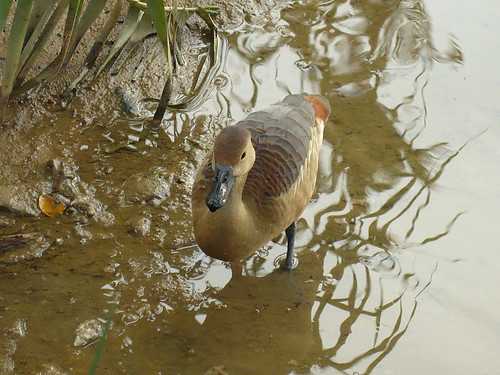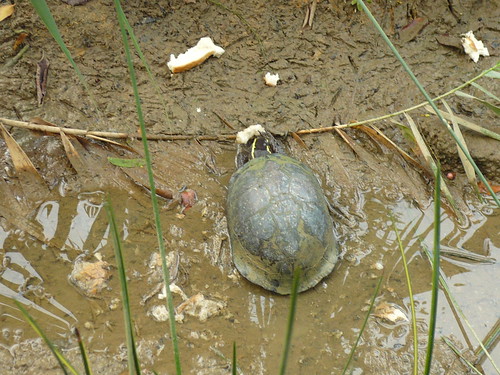Mary Poppins might mean well, but unfortunately, feeding the birds does have its ecological consequences.
After writing two posts in a row about people who feed birds, based on this article and this article on STOMP, this song came to mind. And how coincidental that one of my favourite bloggers, Darren Naish of Tetrapod Zoology, should then write a short post telling people why the old habit of feeding bread to ducks at the nearby pond is a very bad idea.
I don't know about the rest of the world, but in Britain there is a very entrenched tradition of 'feeding the ducks'. People go on walks (usually at the weekend), and they take with them bagfuls of bread (sometimes even whole loaves). They then proceed to throw all the bread in the water. After a while the ducks and other birds at the pond get bored or full, and they stop eating it. Then more people come and throw in more bread. More people come, and they throw in more bread. Then more, and so on and on. On any given day, the most popular 'duck ponds' are polluted by, literally, kilos of bread.
Here in Singapore, feeding the ducks is not a common practice, since we don't have many resident populations of ducks inhabiting our urban lakes and ponds. In terms of anseriform diversity, Singapore is quite lacking in this regard; only 2 resident species are native to Singapore, the cotton pygmy goose (Nettapus coromandelianus) and lesser whistling duck (Dendrocygna javanica), and only the latter species is known to inhabit wetlands, marshes and ponds close to human activity.

Lesser whistling duck, Singapore Botanic Gardens
Other species more typical of temperate Eurasia, such as the gadwall (Anas strepera), garganey (Anas querquedula), Eurasian wigeon (Anas penelope), northern pintail (Anas acuta), common teal (Anas crecca), northern shoveler (Anas clypeata), and tufted duck (Aythya fuligula), are rare vagrants and winter visitors, and on the occasions when they have been spotted, were seen in isolated marshy areas. The most recent record of one of these species was that of a lone female northern shoveler at Sungei Buloh.
Finally, there is a number of species which were introduced to Singapore, most likely as ornamentals. Free-ranging populations exist, especially in the Singapore Botanic Gardens, although the number of individuals is small, and it remains to be seen if these populations are truly self-sustaining. These include familiar species like the domestic goose (Anser anser), mute swan (Cygnus olor) and black swan (Cygnus atratus), as well as more exotic species like the Radjah shelduck (Tadorna rajah) and Mandarin duck (Aix galericulata). So far, the wandering whistling duck (Dendrocygna arcuata) is the only non-native anatid which is known to breed locally.




Upper left: mute swan; Upper right: black swan;
Lower left: wandering whistling duck; Lower right: Radjah shelduck;
(Photos by Marcus)
Four species of non-native anatid which can be spotted at the Singapore Botanic Gardens
And so, unlike many temperate countries, Singapore does not really have large populations of urban waterfowl waiting to be fed.
The Singapore Botanic Gardens is the best place to spot a variety of waterfowl, both native and non-native. I can't recall whether visitors are allowed to feed the swans and ducks or not. In any case, when I was there in March last year, I did see people tossing chunks of bread to the fish, and my first sighting of a Malayan box turtle (Cuora amboinensis) in the wild was due to the turtle crawling out of the water to munch on some bread.

Malayan box turtle eating bread, Singapore Botanic Gardens
Since there are not many urban waterfowl here in Singapore, most people bringing bread to our parks and gardens are there to feed the fishes and turtles which can be found inhabiting almost every pond and lake. I've seen it occurring on a regular basis in the Singapore Botanic Gardens and Chinese Garden.
I'm not sure if handouts from well-meaning park visitors form a substantial proportion of the fishes' nutritional intake, but then again, many of these ponds do seem quite severely overcrowded, and I doubt the ponds would be able to support that many fish if not for the presence of food deliberately tossed in from above. Most of the fish that benefit from these offerings are non-native fishes, with koi (Cyprinus carpio), tilapia (Oreochromis spp.), and sailfin armoured catfish (Pterygoplichthys spp.) as the most common species. Another aquatic species very commonly seen feeding on food offered by visitors is the red-eared slider (Trachemys scripta elegans). As such, these introduced species almost completely dominate the ecosystem. It is possible that native aquatic life is adversely impacted by the high numbers of non-native fish and turtles. Not only are other fish and turtle species affected due to competition and disease, but amphibians, arthropods, and molluscs might be excluded from certain ponds and lakes due to heavy predation. On the other hand, all these fish are important prey for large piscivorous birds such as raptors and herons, while the young fish support a host of smaller predators.
For some reason, the issue of feeding the fish in Singapore does not appear to be as problematic as feeding of ducks is in Britain and elsewhere. Although many of the aquatic plants and animals now found in and around our urban ponds are not native in the first place, it still goes to show that despite the possible pollution problem posed by overcrowding and overfeeding, even the most overpopulated ponds and lakes still manage to support a variety of other organisms.
Eutrophication does not seem to be a serious problem, although most of these ponds are admittedly rather mucky and full of algae. Presumably, all the uneaten food, and the droppings produced by the unnaturally high concentrations of fish and turtles, combined with our tropical climate, contribute to thick algae blooms. Given that koi and tilapia spend a lot of time foraging on the bottom, which stirs up a lot of sediment, this could be another factor as to why the water in these ponds is far from crystal clear.
Maybe it's because the species which manage to survive in these ponds and lakes are highly resilient, adaptable and tolerant of some level of pollution. Many of the fish found in these waters, both natives and non-natives, are capable of breathing atmospheric air, so low dissolved oxygen content does not present much of a problem. In fact, given that many of these species are adapted to living in stagnant pools, swamps and rice paddies, the living conditions found in urban ponds might not be that challenging after all. And as long as there is sufficient aquatic vegetation to provide hiding places, and shallow areas inaccessible to large fish, other aquatic organisms are still able to survive in these ponds.
Of course, one wonders what would happen if the feedings should stop. Will the ponds still be able to support such high fish populations, or would there be mass die-offs of fish? Would the starving fish end up decimating the ecosystem, or even cannibalise each other?
I have to admit, a simple act like feeding the fish or ducks can be a calming, therapeutic experience, and is an excellent way for parents to encourage their children to develop a sense of compassion for animals. And here in Singapore, where we do not possess large populations of tame waterfowl, and where urban ponds are typically entirely artificial constructs, the ecological impacts of feeding might not be so apparent. The ecology of our urban ponds and lakes is extremely complicated, involving a hodgepodge mix of native and non-native species. Feeding of fish might have both positive and negative impacts on the ecosystem as a whole, but this is an area that does not seem very well-studied. It certainly is an area worth looking into, to see if feeding of fish and turtles has any severe long-term consequences for the health and diversity of urban aquatic habitats.